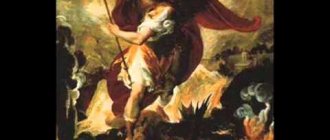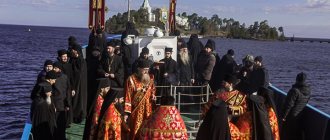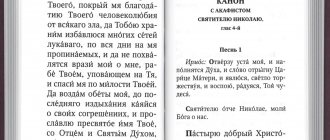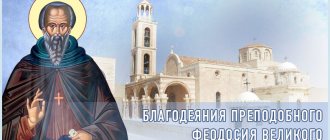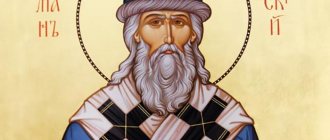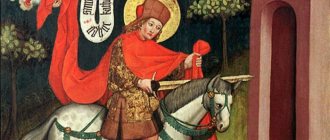Saint Basil the Great. Biography
Saint Basil the Great was born around 330 in Caesarea in Cappadocia. His parents were of noble birth, and were also distinguished by their zeal for the Christian faith. His grandparents suffered during the persecution of Emperor Diocletian, and his uncle was a bishop, as were two brothers - Gregory of Nyssa (c. 335–394) and Peter of Sebaste . Vasily's father was an orator and lawyer and wanted Vasily to follow in his footsteps. Basil received an excellent education in Caesarea and Constantinople, and then studied at the Athens Academy. In it he met Gregory the Theologian (329–389).
Upon his return to Caesarea, Basil became involved in secular affairs, but thanks to the influence of his pious sister Macrina (324 (327 or 330)–380), Basil began to lead a more ascetic life and eventually left the city with several friends and settled on family lands in Ponte. In 357, Basil went on a long journey through Coptic monasteries, and in 360 he accompanied the Cappadocian bishops to the synod in Constantinople. Shortly before the death of the Caesarea bishop Diania, Basil was ordained a presbyter and became an adviser to Bishop Eusebius, who succeeded Diania after his death. Eusebius did not like Vasily’s strict ascetic life, and Vasily decided to go into the desert, where he began to establish a monastic life.
The rise to power of the Arian emperor Valens (328–378) and the growing oppression of Christians led Eusebius to seek the help of the active and diligent Basil. In 365, Basil returned to Caesarea and began to govern the diocese. He wrote three books against the Arian heresy, preaching "three hypostases in one essence." Despite the opposition of a number of bishops, after the death of Eusebius in 370, Basil took over as Metropolitan of Cappadocia and began to eradicate Arianism in Asia Minor. Basil's efforts to eradicate Arianism brought him into conflict with Valens. During the emperor's trip to Cappadocia, the bishop categorically refused to recognize the correctness of the Arian teachings. In response, Valens divided Cappadocia into two provinces, which reduced Bishop Basil's canonical territory and undermined his position in the Church. Nevertheless, Vasily managed to promote his comrades Gregory of Nyssa and Gregory the Theologian to the place of bishops of key cities. At this time, the struggle for the patriarchal throne in Antioch began, on which Basil did not want to see the Nicene Paulinus, fearing that an excessive exaggeration of the unity of God was fraught with the heresy of Sabellianism.
Emperor Valens died at the Battle of Adrianople (378). Bishop Vasily's health was undermined by his ascetic lifestyle. He died on New Year's Day 379. Saint Basil left us many theological works: nine discourses on the Sixth Day, 16 discourses on various psalms, five books in defense of the Orthodox teaching about the Holy Trinity; 24 conversations on various theological topics; seven ascetic treatises; monastic rules; ascetic charter; two books about Baptism; a book about the Holy Spirit; several sermons and 366 letters to various persons.
Library of the Russian Faith The Life and Miracles of Our Father Basil the Great, Archbishop of Caesarea in Cappadocia. Great Menaion of Cheti →
Read online in original
Characteristics of the birthday boy Vasily:
From the ancient Greek language - “royal”. Wed. with the words “basilica” - royal tomb, “basilisk” - “king”, mythical dragon. The king in Ancient Greece was called "basileus". Perhaps the word originally comes from the name Vasitta - the tallest (from the Sumerian language) or Vasishta (the richest) and Basu (kind) - the names of the gods in Vedic mythology (India).
The Vasilys of our time are very sociable people. They cannot imagine their life without friends and comrades and daily meetings with them. However, there is another type of Vasily, who devotes all his free time from work to family, children and sports exercises (for health). Monogamous He is a good specialist. He is valued by management and his opinion is taken into account. By the way, this also applies to the first type of Vasiliev - those who like to spend their free time in cheerful companies of like-minded people.
In everyday life, Vasily is balanced, stubborn, hardworking, and efficient. In face (appearance) they resemble their mother, in character they resemble their father. They are kind, but in moderation - they know their worth! Vain. Winter Basils are more complex. They love to reason and philosophize on the topics of life and death, that “everything will pass, there is no salvation, the color of your lips will fade, you will lie in the damp earth, and then I, dead myself, will not admit to the dead that I loved you alive... So love while you are alive, give love your rights...", etc.
Of course, such a philosophy is very convenient for taking a walk on the side, leaving like Odysseus, from his wife, from his children. And women, Vasily believes, must wait for him constantly, day and night. After all, he, Vasily, considers himself extraordinary, special, literally a sexual giant.
He is constantly haunted by the thought of how to achieve a high position in society. The thirst to dominate constantly accompanies him throughout his creative career. In his old age, Vasily is a big bore who constantly grumbles... Many of them become drunkards.
And in business, and in rest, and in the construction of life, and in caring for himself, Vasily is not guided by outwardly and formally set standards. He can be cruel, even violating norms in the name of a set goal, but he can also be immensely generous, when this generosity can be shown by a single act of will, a single wave, and at the same time he will even less take into account any norms and requirements of law , and even morality. This says a lot, because as an organizer, administrator, builder of life, Vasily cannot simply, frivolously treat norms, imposing and implementing them himself. But when it is really necessary, he is able to autocratically abolish the norm this time and implement what is now exactly required, even if it is in complete contradiction with the formally and literally understood rule of everyday life. He knows how to do this with authority, without staining his conscience and without being internally forced as a result of such a retreat to further violations of the same rule.
Veneration of St. Basil the Great
Saint Amphilochius, Bishop of Iconium (c. 340–394), in his funeral homily about Saint Basil said:
He has always been and will be a most saving teacher for Christians.
For his services to the Church of Christ, Saint Basil is called the Great and is glorified as “the glory and beauty of the Church,” “the luminary and eye of the universe,” “the teacher of dogmas.” Saint Basil the Great is the heavenly patron of the enlightener of the Russian Land - the holy Equal-to-the-Apostles Grand Duke Vladimir, in holy baptism Vasily. Prince Vladimir revered Saint Basil and erected several churches in his honor in Rus'. Many Russian rulers were named after Basil the Great at baptism, in particular, Vladimir Monomakh (baptized Vasily), Vasily I, Vasily II. Saint Basil the Great, along with Saint Nicholas the Wonderworker, is especially revered by the Russian people. A particle of the relics of St. Basil is located in the Pochaev Lavra. The honorable head of the saint is kept in the Lavra of St. Athanasius on Athos, and his right hand is in the altar of the Church of the Resurrection of Christ in Jerusalem. The memory of St. Basil the Great is celebrated on January 14 (January 1, old style) and February 12 (January 30, old style) - in the Cathedral of the Three Hierarchs.
Heritage
Saint Basil lived a short life - 49 years, but left a rich spiritual heritage. His main merit was his joint development with like-minded people of the dogma of the Holy Trinity and the approval of this teaching at a meeting of all Orthodox bishops. The saint did a lot to introduce monasticism into the fold of the Church; he wrote many works in which he denounced heresy.
His famous work is “The Six Days”. It provides an interpretation of the biblical description of the Divine Universe in the form of conversations. Basil the Great composed the famous liturgy, which is served only 10 times a year on major holidays, including January 14 in honor of the author.
Troparion, kontakion and canon to St. Basil the Great
Troparion, tone 1:
To the whole2 earth your message has come, as your word has come, and you have taught 3si2, and 3 the nature2 of those who exist. humanely decorated є3сi2. This is a great meaning, and the Lord, pray to God to save our people.
Kontakion, tone 4:
The Kwi1cz pillar of immovable churches, giving everyone the inestimable earthly wealth, was imprinted by your disciples, your heavenly teacher.
Library of the Russian Faith Canon to St. Basil the Great →
Read online
Who was born on the 14th
- 83 BC e. – Mark Antony, Roman politician and military leader.
- 1875 – Albert Schweitzer, German theologian and physician, Nobel Peace Prize laureate in 1952.
- 1883 – Nina Ricci, French fashion designer, founder of the high fashion house Nina Ricci.
- 1941 – Faye Dunaway, American actress, Oscar winner.
- 1967 – Emily Watson, English theater and film actress.
- 1973 – Giancarlo Fisichella, Italian racing driver, participant in the Formula 1 championship.
Folk traditions on the day of St. Basil the Great
The eve of Vasilyev's Day was popularly called Vasilyev's evening. Among the northwestern Slavs, he received the name “generous”, “generous”, “rich”, because on this evening they took out the best from the storerooms; in central and southern Russia - “Avsen”, “Ovsen”, “Usen”, “Tausen”. The favorite Christmas pastime for young people was fortune-telling; they were considered the most accurate and valid just before the New Year, on Vasiliev's evening. All types of fortune-telling were dedicated to this day, despite the fact that pious people considered this a great sin. Almost all methods of fortune telling have one goal - to find out how soon, where and to whom they will marry (or who they will marry) and how life will turn out in someone else's family.
Saint Basil the Great was revered as the patron saint of pigs, which is why people also called this holiday the pig holiday. On the holiday, they slaughtered cattle, stabbed the so-called “Caesaret” piglets (named after Basil the Great, Archbishop of Caesarea), so that the table would be hearty, meaty, and they said: “A pig and a boar for Vasily’s evening.” One of the main dishes was a stuffed pork head: “On Vasily’s Day, a pig’s head on the table!” “The pig is not a clean animal,” one can hear among the people, “but God has nothing unclean: the fire burns the bristle pig, but Basil of the winter will sanctify it!” Roasted Caesaretian pig is considered a common property: all fellow villagers can come and eat it, and each of those who come must bring at least a little money, which is given to the owner, and the next day is transferred to the parish church and goes to the clergy. Custom requires that the Caesaret pig must be roasted and served whole (uncut), at least in size it resembles a large pig. Before eating, the eldest in the family raises the cup with the pig up to three times, saying: “So that the pigs piggy, the sheep lamb, and the cows calve.”
According to folk custom, a rich table on Vasily’s Day will provide the owner with prosperity for the whole year
Also, kutya was always served on the table. Unlike kutya on Christmas Eve (“lenten”) and Epiphany (“hungry”), it was “rich”; cream, butter, almonds, and walnuts were added to it. The table was not inferior in its assortment of dishes to the Christmas feast. Many customs were associated in the popular imagination with Vasilyev's evenings. And now in some places such customs as cooking “Vasil porridge”, sowing grain or going from house to house are observed.
Painting by Alexander Mitsnik
After the festive dinner, there was a tradition of going to neighbors and friends and asking each other for forgiveness. Vasily's Day was especially popular among young people. They could woo again if they had previously been refused. On this day, children liked to scatter grains of spring bread throughout the huts: “sowing” was a kind of ritual. The housewives then collected the grains and stored them for sowing. Gardeners also especially prayed to St. Basil the Great, asking him to save fruit trees from pests. In some places there was a custom to shake off trees that evening with the saying: “As I shake off the white fluffy snow, so Saint Basil will shake off every worm-reptile in the spring!”
Old New River
On September 14, 2022, the Old New River is designated. To this saint is given the Generous Evening (Melanki) on the 13th of today. The New River itself is celebrated on the evening of the 13th to the 14th, accompanied by a holy rich table setting, dancing, fun and generosity.
The tradition of keeping the Old New River holy became a result of the separation of the Julian and Gregorian calendars. According to the old style, New Year's Eve falls on the 14th day, which is why it is customary to mark this day. Before speaking, for rich believers, the Old New River is more sacred, the lower New River has a new style. Even the stench can make the soul feel holy only after the end of the Holy Fast.
Traditionally, on this day, the ancestors laid many tables, placing at least 12 sieve on them. The celebration of the Old New Rock is accompanied by generous gifts, during which time the company dresses up in colorful clothes or characters, and puts on masks. They walk from house to house, sing generous songs (ritual songs) and in this way make people feel good.
Vrantz is the 14th day of sowing. According to tradition, cotton crops or men are sown with wheat and livestock. Ale may also be used against other grains. It is the duty of the man or the boy to leave the booth, so as not to ruin his luck.
Saint Basil the Great. Icons
According to the iconographic original of the 16th century, St. Basil the Great was depicted in frescoes and icons wearing a light cross-haired phelonion, with his right hand blessing the people, and holding the Gospel in his left. Initially, Basil the Great was depicted frontally, chest-to-chest, as on the 7th century icon. from the monastery of the Great Martyr Catherine in Sinai. Later, full-length images of the saint appeared. On the icons of the 11th century, Basil the Great is depicted bowed in prayer, with an unrolled scroll in his hands.
Saint Basil the Great. Fresco. Serbia (Studenica). 1209
Basil the Great. From the Deesis rank. OK. 1486 Museum named after. Andrey Rublev
Saint Basil the Great. Fragment. Image by Theophanes the Greek. 1405
At the end of the 11th century, the celebration of the memory of the Three Hierarchs (Basily the Great, Gregory the Theologian and John Chrysostom) was approved in Byzantium. In this regard, joint images of the Three Hierarchs became widespread. In Ancient Rus', festive icons of the Three Hierarchs became widespread from the 15th century, often as part of menain tablet icons, for example, “Trinity” (2nd quarter of the 15th century), “Sophia” from Veliky Novgorod (late 15th century).
Three saints: Basil the Great, John Chrysostom and Gregory the Theologian. Icon. Beginning of the 17th century Church-Archaeological Cabinet of the Moscow Theological Academy
In the Byzantine art of the Palaiologan period, compositions appeared that revealed the theme of the teaching of the holy fathers, for example, “The Conversation of the Three Hierarchs” or “The Blessed Fruits of the Teaching” in the frescoes of the Church of the Archangels in Lesnov, Macedonia (1347–1349). Basil the Great sits behind a music stand with a cross-shaped base, from which streams of water emanate, i.e. "river of learning" Such iconographic images of the saint appeared in Rus' in the 16th–17th centuries. entitled “Conversation of Basil the Great, Gregory the Theologian and John Chrysostom”, “Teaching”, or “Good Fruits of Teaching”, for example, in the mural of the Cathedral of the Nativity of the Virgin Mary of the Ferapontov Monastery (1502).
Conversation between Basil the Great, Gregory the Theologian and John Chrysostom (“Good Fruits of the Teaching”). Savin Nikifor Istomin. Beginning of the 17th century State Tretyakov Gallery, Moscow
In Moscow icon painting, illustrations of the life of Basil the Great are more common. The Russian face list of the Life of Basil the Great of the 3rd quarter of the 16th century is distinguished by its exceptional wealth of iconographic subjects (225 sheet miniatures). from the collection of M. A. Obolensky. Russian monuments of the 17th century. were distinguished by an increase in the number of hagiographic episodes and great decorativeness.
Note 14 today
- The sky is clear and bright - I am harvesting plenty of berries.
- Fog on the Old New River - before birth.
- Vasily needs to put greased pig on the table so that he becomes thin.
- Happy Vasily's day - the whole river is good.
- The storm on Vasily - until the harvest of peas.
- The month is on the decline - spring will not be wet, the month is on the rise - in the spring there will be plenty of water.
- Since the people were born on Vasil, they will be rich. In the jasper there is a talisman, its trace is to wear jasper.
Temples in Rus' in the name of St. Basil the Great
The first temple, built by Prince Vladimir in Kyiv on the site of a pagan temple, was consecrated in the name of Basil the Great. Prince Vladimir also erected the Church of St. Basil in Vyshgorod, where the passion-bearing princes Boris and Gleb were originally buried. In the 12th century, churches were built in the name of Basil the Great in Kyiv, Novgorod, Ovruch and in Smyadyn near Smolensk. In the XIII–XV centuries. churches in honor of Basil the Great were built in Tver (before 1390), Pskov (before 1377) and in other cities.
The church in the name of St. Basil the Great in Ovruch (Ukraine) is part of the complex of St. Basil's Convent (UOC MP). The temple was built in 1190 by Prince Rurik Rostislavovich (d. 1212). The construction of the church was led by the architect of Ancient Rus' Peter Miloneg. In 1321, the Vasilyevskaya Church in Ovruch was almost completely destroyed by the Lithuanians, restored in 19070–1909 by the famous architect A.V. Shchusev. Fragments of ancient Russian frescoes have been preserved in the temple.
In the name of St. Basil the Great, a temple was consecrated in the city of Vladimir-Volynsky (Ukraine). The exact date of construction of the church is unknown. According to researchers, the church building dates back to the 70–80s of the 13th to mid-14th centuries. The first documentary information about this monument dates back to 1523. In 1695 the church was in disrepair, and it remained the same in the 18th century. The monument was rebuilt and completed more than once. The interior was decorated with frescoes, whitewashed at the end of the 17th century. Significant works that changed its original appearance were carried out in 1900–1901. designed by architect N.I. Kozlov.
In the name of St. Basil, the Church of Vasily on Gorka in Pskov was consecrated. The wooden temple on the site of the stone one was built in the 14th century on a hill rising in a swampy area in front of the Zrachka stream. In 1375, a wall of the Middle City was built along the bank of the stream and the Vasilyevskaya Tower was erected opposite the church, over which a belfry was built. In 1377 the temple was painted. In 1413, a stone temple was erected on the site of the wooden church. The end of the 15th century and the 16th century are a period of prosperity; at this time, chapels and a gallery were added to the temple. At the beginning of the 16th century, the revered temple icon of the Tikhvin Mother of God was painted.
In the Tverskaya Yamskaya settlement of Moscow there once existed a church in the name of St. Basil. The exact time of construction of the temple is unknown. The first mention of the church of Basil, Bishop of Caesarea, in the sources is found in the census of 1620–1621. This church was wooden, cut down "kletski". In 1671, all the buildings of the Tverskaya Yamskaya Settlement were destroyed by fire. In 1688, construction began on the stone Church of Basil of Caesarea. In May 1934, the temple was closed and destroyed.
In Kyiv on the street. Victims of the Revolution (formerly Three Saints) until the 30s. XX century there was a church in the name of three saints - Basil the Great, Gregory the Theologian and John Chrysostom. Previously, this church was called Vasilyevskaya. It was built in the early 80s. XII century Prince Svyatoslav Vsevolodovich at the princely courtyard and consecrated in 1183: “The Church of St. Basil, which stood in Kyiv at the Great Courtyard, was sacred.” After the Mongol invasion, the church was built only in the 16th century. was restored, and in the middle of the 17th century. burned down. At the end of the 17th century. the church, which stood without vaults, was again restored. In 1935-1936 it was dismantled.
The lost temple of St. Basil the Great in Kyiv. Drawing from the magazine “Zodchiy”
Numerological analysis
The name Vasily in numerology is characterized by the number 4. It is responsible for stability, reliability and integrity. Such a person is purposeful, efficient and attentive to details.
According to the numerological interpretation, Vasya is prone to depression and prefers to go to his goal alone. Thrifty, faithful family man, loving father. Conservative, pragmatic, sometimes petty. He loves company, often gets together with friends, and appreciates the warmth of human communication.
Old Believer churches in the name of St. Basil the Great
In the name of St. Basil the Great, the Church of the Russian Orthodox Church in the city of Solikamsk, Perm Territory, was consecrated. The Old Believer Church was built in the early 1990s under the care of the Krechetov family, consecrated in 1995, and the bell tower built in 1999. In 2000, the temple, excluding the bell tower, burned down and was rebuilt.
In the village Zolotilovo, Ivanovo region in 1895-1915. A Russian Orthodox Church church was built in honor of St. Basil the Great. The church is currently abandoned.
In 1854 in the southeast of Romania in the village. Sarikoy built the RDC Church in the name of St. Basil the Great.
Features of worship
The liturgy in honor of the saint has some peculiarity. This service is held on January 14, as well as on Sundays of Lent, Maundy Thursday and Saturday.
- The liturgy lasts much longer than the service of John Chrysostom. Believers notice that the chants become longer due to the increase in the text of the prayers.
- The chief priest secretly pronounces the Eucharistic prayer, and the choir fills the pauses in the divine service.
- Then, instead of “It is worthy to eat,” they fulfill the petition “He rejoices in You.”
- The name of the saint is pronounced twice: in the proskomedia (the first part of the liturgy) and at dismissal.
The Day of Remembrance of St. Basil the Great is celebrated annually on January 14, and the Divine Liturgy is held on the same day as the celebration of the Circumcision of the Lord.
The saint gained enormous fame among Christian followers: he led a strict ascetic life, studied the Holy texts daily and spent a lot of time in prayer. Having studied almost all sciences, he received the rank of bishop, which allowed him to fight the Arian heresy.
Read about the saint:
- Life of St. Basil the Great
- Icon of St. Basil the Great
- Prayers and Akathist to Basil the Great

